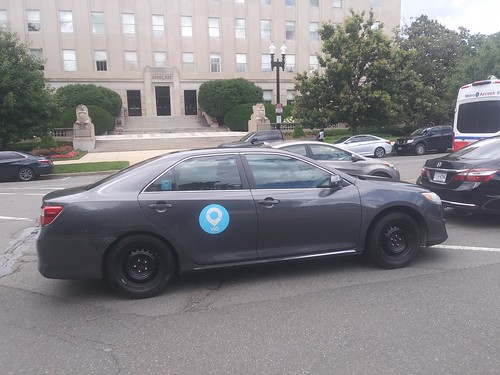Why microtransit isn't likely to be a source of great profits for private firms: labor
In doing filing, I came across a columnist writing about autonomous vehicles back in 2017. She made the point that new technologies and ways of doing things are often oversold in the short run, but have great influence over the long run.
What is now called "microtransit" isn't new. For example, for many years I've written about free neighborhood shuttle bus routes in Tempe, Arizona and "shared taxi services" at the outskirts of transit service zones in Montreal.
Microtransit is the "new" term for shuttle buses and the like, including services such as UberPool, Via, and various failed services like Bridj.
-- "Where's the revolution?: Bridj microtransit service shuts down (a/k/a "Mobility as a Service")," 2017
Anyway, this ad I saw on the back of a Metrobus for Via, which is a semi-fixed route "shuttle" aiming to move people within districts, usually focused on getting people to and from rail transit stations, communicates the reality of why microtransit is not likely to be financially viable for private sector service.

Labor costs a lot. Fares are comparatively low. And there aren't a lot of riders.
If you paying $200/8-hour shift for 14 shifts/week, that's almost $3,000/week. Plus the cost and depreciation of the vehicle, insurance, and variable expenses to gas up and maintain the car, soft infrastructure to run the service, etc.
It's not that this kind of what I call "intra-neighborhood" service isn't important to provide, depending on the situation ("Carlsbad to launch innovative ‘first-last mile’ program to boost transit ridership," San Diego Union-Tribune; "They’re like Uber but free: New electric shuttles popping up all over South Florida," Fort Lauderdale Sun-Sentinel). The San Diego County service will be free to riders of the commuter train, and costs $2.50 for others to ride.
The Fort Lauderdale service is free, paid for by local governments and a combination of ad and sponsorship sales. From the Ft. Lauderdale article:
Partnering with local governments and private advertisers, several companies are building fleets of low-speed street-legal six-seat electric shuttles to ferry the permanently or temporarily car-less over short distances within congested urban zones....
Pedestrians in busy sections of Fort Lauderdale, Palm Beach and West Palm Beach can use smartphone apps to summon rides from two growing services: Freebee, in the middle of a pilot program in a square-mile section of downtown Fort Lauderdale, and Circuit (formerly The Free Ride), which serves Fort Lauderdale’s beachfront resort area and last week began shuttling tourists and commuters in the core area of Hollywood.
Jason Spiegel, a University of Miami grad who started Freebee in 2011 with fellow Hurricane alum Kris Kimball, said his company can make money giving away free rides by pursuing three business models:But it must be recognized that success at advertising is likely to be in tourist areas and downtowns, not in "the average neighborhood."
One model calls for cities to fund the entire operation as if it was their own.
Under the second, the city pays a contracted rate that gets reduced as advertising is sold. Prior to its current deal with Freebee, Coral Gables agreed to pay $300,000 a year and saw that amount reduced to $110,000 after Baptist Health came on board as sole sponsor. But when the contract came up for renewal, Coral Gables decided it didn’t want outside advertising and agreed to pay $486,000 to expand from three to five vehicles and keep its service self-branded, Spiegel said.
Under the third model, ad revenues fund the entire operation. Riders are greeted with ads not only wrapped around the outside of the vehicles, but inside and on mounted tablets. Often drivers pass out product samples provided by the advertisers. Riders can take selfies with the tablets, send them to their friends and even listen to their requested music, Spiegel said.
Note that I define intra-neighborhood services like these, which include standard shuttles serving private organizations, as part of a community/metropolitan area's "tertiary" transit network.
-- "Intra-neighborhood (tertiary) transit revisited because of new San Diego service," 2016
But getting back to autonomous vehicles, which in the long run (at least 10 years down the road) are more likely, eliminating the cost of direct labor for such a service will significantly change the cost structure and then perhaps such a microtransit service could be a viable for profit venture.

Labels: change-innovation-transformation, innovation ecologies, product-service systems, sustainable mobility platform, transit marketing, transportation demand management, transportation planning




2 Comments:
Failure of microtransit in Orange County, CA
article pitched as suburban mobility.
1. Most people own cars.
2. Deconcentrated destinations
3. Therefore, not enough riders
https://www.collegetowns.org/p/rip-oc-flex-or-how-difficult-public
RIP OC Flex or: How Difficult Public Micromobility is in Suburbia
5/19/25
Lyft Revives Pooled Rides at Airports in Push for Cheaper Trips
https://www.bloomberg.com/news/articles/2025-05-19/lyft-revives-pooled-rides-at-airports-in-push-for-cheaper-trips
Post a Comment
<< Home